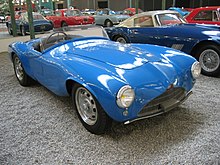Roland Bugatti
Roland Cesare Mario Carlo Bugatti (born August 23, 1922 in Dorlisheim , † March 29, 1977 in Aix-en-Provence ) was a Franco-Italian automobile manufacturer and engineer. He was the second son and the youngest of four children by Ettore Bugatti and his wife Barbara. He was the younger brother of Jean Bugatti . After the Second World War, Roland Bugatti was the owner of the car manufacturer Bugatti . He made several attempts to revive the brand that was legendary in the prewar period, but was unsuccessful.
biography
After the death of his brother Jean Bugatti in 1939, his father Ettore Bugatti established him as the designated successor in the company. Company founder Ettore Bugatti died on August 21, 1947. During Ettore's lifetime, around 7,900 vehicles were built with his name on the radiator grille, of which 2,000 are still preserved today. At this point in time (1947), Roland Bugatti was just 25 years old when he took over his father's company. He took the former test driver and loyal Bugatti employee Pierre Marco as a partner in the company. Ettore's heirs had previously appointed him as managing director of the company. Like Ettore Bugatti before, they tried to revive the Bugatti brand after the Second World War.
Roland Bugatti has been honorary president of the Swiss Bugatti Club "Bugatti Club Suisse" (BCS) since 1951 .
Attempts to revive the Bugatti brand

Bugatti built new cars on pre-war chassis that had survived the turmoil of the war unscathed and sold under the name Bugatti Type 101 . The Type 101 was the official successor to the Bugatti Type 57 . Many enthusiasts regard it as the last real Bugatti, but it was unsuccessful mainly because of its outdated technology. Eight copies of the Type 101 were produced in Molsheim between 1951 and 1956 and six of them were sold.
In 1951 Roland took over the management of the company together with René Bolloré , the second husband of Ettore's widow Geneviève Marguerite Delcuze . Since then, Bugatti has mainly serviced old vehicles and the railcars built by Bugatti in the 1930s, and most recently built engines for the French army . On the one hand, however, the cars produced by the company did not stand a chance against the more technically advanced new developments by French and international competitors, and on the other, the Bugatti brand's financial situation was poor, so that in 1956 the production of cars was discontinued.


Roland Bugatti tried again in 1956 with the Bugatti Type 251 to make a fresh start in Formula 1 . The last time a Bugatti racing car started at the French Grand Prix in Reims . The driver was Maurice Trintignant . The mid-engine monoposto type 251 only managed 18 laps before it rolled out on the runway due to a defective throttle cable. The Bugatti Type 252 racing car that he designed as a successor did not get beyond prototype status. Until 1963 the company carried out repairs and conversions of old Bugattis.
Roland Bugatti finally sold the company to the French aerospace group (and former automobile manufacturer) Hispano-Suiza in 1963 due to accumulated high debts and losses . In the same year the collectors Fritz and Hans Schlumpf acquired all the remaining Bugattis from Roland Bugatti and the other heirs, including all prototypes, engines and spare parts for their collection. At the same time, they contractually secured the right to overhaul, repair and overhaul the car.
See also
literature
- In short, Joachim: Bugatti. The Myth - The Family - The Company 2005, ISBN 978-3-430-15809-1
- Uwe Hucke and Julius Kruta: Bugatti. From Milan to Molsheim , Münster 2008, ISBN 978-3-938568-39-2
Web links
- Bugatti history at www.bugatti.com
- www.club-bugatti-france.net
- 100 years of Bugatti Magazine from www.carpassion.com
Individual evidence
- ^ Bugatti Club Suisse history. In: bugatticlub.ch. June 5, 2011, accessed September 13, 2011 .
- ↑ Matthias Kierse: 100 years Bugatti. In: carpassion.com. June 12, 2009, accessed September 13, 2011 .
| personal data | |
|---|---|
| SURNAME | Bugatti, Roland |
| ALTERNATIVE NAMES | Bugatti, Roland Cesare Mario Carlo (full name) |
| BRIEF DESCRIPTION | Franco-Italian automobile manufacturer and engineer |
| DATE OF BIRTH | August 23, 1922 |
| PLACE OF BIRTH | Dorlisheim |
| DATE OF DEATH | March 29, 1977 |
| Place of death | Aix-en-Provence |

